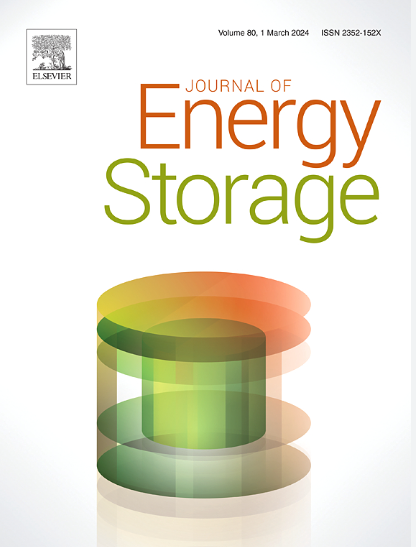Mass production of ultralight graphene films by electrophoretic deposition to improve performance of lithium-ion and lithium-sulfur batteries
IF 8.9
2区 工程技术
Q1 ENERGY & FUELS
引用次数: 0
Abstract
Graphene films are promising to improve cycle performance and rate capability of LiNi0.5Mn1.5O4 (LNMO) and lithium‑sulfur (Li![]() S) batteries. However, designing and fabricating ultralight and uniform graphene films directly on prepared electrodes or separators using simple, versatile, and high efficiency methods are still challenging. In this work, p-Phenylene diamine (pPD) reduced graphene oxide (pPD-rGO) films are deposited on the surface of LNMO electrode via electrophoretic deposition (EPD). The pPD-rGO modified LNMO electrode (LNMO/pPD-rGO), with the high LNMO loading (9 mg/cm2) and the ultralight pPD-rGO films loading (19 μg/cm2), remains 92.7 mAh/g with the capacity retention rate of 80.2 % after 1000th cycle at 1C. Moreover, a novel and unique EPD device is designed and assembled to present overlong and ultralight pPD-rGO and less defect graphene (LDG) films on commercial PP separators. The area density of pPD-rGO and LDG films are 17 and 100 μg/cm2, only accounting for 0.9 % and 5.5 % of PP separator weight, respectively. The pPD-rGO modified PP separator (PP/pPD-rGO) using in LNMO electrode enhances the capacity retention rate of 1000th cycles from 66.2 % to 80.6 %. The LDG modified PP separator (PP/LDG) using in high sulfur loading electrode (5 mg/cm2) not only exhibits the capacity retention rate of 81.1 % after 150th at 0.2C, but also can deliver reversible capacity of 738.9 mAh/g with the decay rate per cycle of 0.068 % after 250th cycle at 0.5C. All results show these ultralight graphene films on electrode or separator by EPD can effectively improve the performance of batteries due to reducing interface impedance. This work not only demonstrates the feasibility of the strategy of graphene films surface modification, but also proclaims the potential of EPD application prospect in high specific energy batteries.
S) batteries. However, designing and fabricating ultralight and uniform graphene films directly on prepared electrodes or separators using simple, versatile, and high efficiency methods are still challenging. In this work, p-Phenylene diamine (pPD) reduced graphene oxide (pPD-rGO) films are deposited on the surface of LNMO electrode via electrophoretic deposition (EPD). The pPD-rGO modified LNMO electrode (LNMO/pPD-rGO), with the high LNMO loading (9 mg/cm2) and the ultralight pPD-rGO films loading (19 μg/cm2), remains 92.7 mAh/g with the capacity retention rate of 80.2 % after 1000th cycle at 1C. Moreover, a novel and unique EPD device is designed and assembled to present overlong and ultralight pPD-rGO and less defect graphene (LDG) films on commercial PP separators. The area density of pPD-rGO and LDG films are 17 and 100 μg/cm2, only accounting for 0.9 % and 5.5 % of PP separator weight, respectively. The pPD-rGO modified PP separator (PP/pPD-rGO) using in LNMO electrode enhances the capacity retention rate of 1000th cycles from 66.2 % to 80.6 %. The LDG modified PP separator (PP/LDG) using in high sulfur loading electrode (5 mg/cm2) not only exhibits the capacity retention rate of 81.1 % after 150th at 0.2C, but also can deliver reversible capacity of 738.9 mAh/g with the decay rate per cycle of 0.068 % after 250th cycle at 0.5C. All results show these ultralight graphene films on electrode or separator by EPD can effectively improve the performance of batteries due to reducing interface impedance. This work not only demonstrates the feasibility of the strategy of graphene films surface modification, but also proclaims the potential of EPD application prospect in high specific energy batteries.

通过电泳沉积量产超轻石墨烯薄膜,以提高锂离子和锂硫电池的性能
石墨烯薄膜有望改善LiNi0.5Mn1.5O4 (LNMO)和锂硫(LiS)电池的循环性能和倍率能力。然而,使用简单、通用和高效的方法直接在制备的电极或分离器上设计和制造超轻且均匀的石墨烯薄膜仍然具有挑战性。在这项工作中,通过电泳沉积(EPD)在LNMO电极表面沉积了对苯二胺(pPD)还原氧化石墨烯(pPD- rgo)薄膜。高LNMO负载(9 mg/cm2)和超轻pPD-rGO膜负载(19 μg/cm2)的pPD-rGO修饰LNMO电极(LNMO/pPD-rGO)在1C下循环1000次后仍保持92.7 mAh/g,容量保持率为80.2%。此外,设计并组装了一种新颖而独特的EPD装置,可以在商用PP分离器上呈现超长、超轻的pPD-rGO和更少缺陷的石墨烯(LDG)薄膜。pPD-rGO和LDG膜的面积密度分别为17和100 μg/cm2,分别仅占PP分离器重量的0.9%和5.5%。将pPD-rGO改性PP分离器(PP/pPD-rGO)用于LNMO电极,可将1000次循环的容量保持率从66.2%提高到80.6%。在高硫负载电极(5 mg/cm2)上使用的LDG改性PP分离器(PP/LDG),在0.2C条件下,在150 h后的容量保持率为81.1%,在0.5C条件下,在250 h后的可逆容量为738.9 mAh/g,每循环衰减率为0.068%。结果表明,通过EPD在电极或隔膜上制备的超轻石墨烯薄膜可以有效地降低界面阻抗,从而提高电池的性能。这项工作不仅证明了石墨烯薄膜表面改性策略的可行性,也宣告了EPD在高比能电池中的潜在应用前景。
本文章由计算机程序翻译,如有差异,请以英文原文为准。
求助全文
约1分钟内获得全文
求助全文
来源期刊

Journal of energy storage
Energy-Renewable Energy, Sustainability and the Environment
CiteScore
11.80
自引率
24.50%
发文量
2262
审稿时长
69 days
期刊介绍:
Journal of energy storage focusses on all aspects of energy storage, in particular systems integration, electric grid integration, modelling and analysis, novel energy storage technologies, sizing and management strategies, business models for operation of storage systems and energy storage developments worldwide.
 求助内容:
求助内容: 应助结果提醒方式:
应助结果提醒方式:


